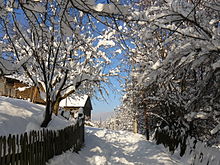Macedonian months
Today's modern names of the months were first being used towards the end of the 19th century, most commonly with the suffix -ја as for instance in words such as јануарија (januarja), февруарија (fevruarija), септемврија (septemvrija), декемврија (dekemvrija) etc.In Gevgelija, S. Tanovikj noted common month names which are displayed in the aforementioned table and there is a difference in the names for May - crešar, June - žitvar, July - biljar, August - prabraždenski, September - bugurojčin (or gruzdober), October - mitrovski or kasim, November - listupad and December - gulemijut mesic or bužikjov.[1] Common names of the months in the village of Valandovo Pirava are the following: koložeg - January, sečko - February, letnik - March, treven - April, cutnik - May, crvenik - June, gorešnik - July, gumnar - August, grozdober - September, listokap - October, snežen - November, student - December.In the Macedonian ethnic region Golo Brdo in Albania, the following names and forms are used for certain months: koložek or kolodžek for January, čerešnar or crešnar for June, žetvar for July, dorvar or drvar for November and jodre for December.[3] According to research performed by ethnologists and anthropologists, the duration of months of the culture of Macedonians was usually counted and determined according to certain holidays and festivities, called medžnici or sinori.
North MacedoniamonthsMacedonianarchaicMacedonian Orthodox ChurchsnowingTajmišteKičevoGevgelijathe village of ValandovoPiravaKožufKavadarcithe Macedonian ethnic regionGolo BrdoAlbaniaVasilicaSaint TryphonBlagovecEremijaEremija (Gjurgjovden)DuhovdenIvandenGolema BogorodicaKrstovdenPetkovdenMitrovdenSaint AnaSlavic calendarJulian calendarCalendarsLunisolarAstronomicalBuddhistChineseEthiopianGregorianLunar HijriSolar HijriUnix timeArmenianAssamese (Bhāshkarābda)AssyrianBaháʼíPawukonBengaliBangladeshiBerberBoranaBurmeseEarthly BranchesHeavenly StemsMinguoSolar termGermanic heathenGeorgianHebrewVikram SamvatIranianJalaliZoroastrianIslamicTabularJapaneseJavaneseKoreanKurdishLithuanianMaithiliMalayalamMandaeanManipuri (Meitei)MelanauMizo (Lushai)MongolianNepal SambatYele SambatPunjabiNanakshahiRomanianSomaliSesothoSlavicSlavic Native FaithTibetanTripuriVietnameseYorubaMesoamericanLong CountCalendar roundCopticEthiopian and EritreanJulianRevisedLiturgical yearEastern OrthodoxSaintsArabianTōnalpōhualliXiuhpōhualliBabylonianBulgarByzantineCappadocianCelticCulāsakarajColignyEgyptianFlorentineFrench RepublicanGermanicHaabʼTzolkʼinMuiscaPentecontadQumranRapa NuiSexagenarySovietSwedishTurkmenHoloceneProleptic GregorianProleptic JulianDarian
